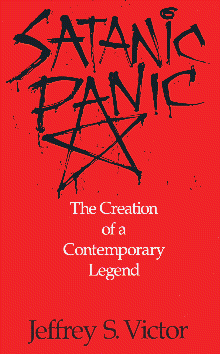so maybe i played d&d once...

Decided to take a break from fiction and wade through some different material, both new finds and books that had been collecting dust. These two constitute the former; a friend lent me Kabbalah and Mckays sold me Satanic Panic, which i couldn't resist after viewing both Paradise Lost documentaries recently (and growing up in a small town in the bible-belt in the late 80s).
Scholem's Kabbalah is broken into four units: history, basic info, topics, and personalities.....so he manages to cover all the bases. Everything from Adam Kadmon, the Sephirot, the Star (or shield) of David, and how to create an awesome golem, all told from a skeptical and historical perspective. What's crucial is the understanding that practically all early christian and medieval magic, and all of the alchemical/cosmological imagery I've seen appropriates Kabbalah in some form. Yet (especially if Spare's ideas of Chaos magick are taken into account) that doesn't mean that the sages' bastardized cut-and-pasting of Kabbalistic, Hellenistic, Arabic, and Gnostic motifs wasn't any less effective......I'm starting to think that any search for some original source of knowledge or mysticism is fruitless (Sumerian, antediluvian, etc). Everyone steals from everyone. The best part is after familiarizing myself with Kabballah a bit, I'm ready to tackle Israel Regardie's Tree of Life (which aludes to the sephirot), which was given to me by a co-worker. I'm not sure why he thought I'd want a book written by Aleister Crowley's secretary, maybe it's the long hair...., but he's right and I'm looking forward to it.

Satanic Panic is a sociological study of the hysteria and mini-witchhunt that went on in small town America in the late 80s and early 90s. I remember freaking out in elementary school about some ridiculous newspaper headline pertaining to devil worshippers in Columbia (which i assumed meant Columbia, TN). I started listening to heavy metal and freaking out at pentagram graffiti, so I felt like i could relate to the subject matter. Victor points out a few key ideas, such as the similarity between persecutions of subversive groups in times of social distress - Satanists in America, witches in Europe, Cathars in France, Jews in everywhere, early Christians in Rome - and the identical allegations that are made towards them - stealing and eating babies, elaborate human sacrifice/blood rituals, fantastic rockin good orgies, etc. He also points out a complete lack of evidence of any organized Satanic religion aimed at dismantling civilization, even though this moniker is thrown at teenagers, child molesters, and new-agers with this assumption in mind. Police often had "ritual abuse" units or experts, even though this term never had any real meaning (outside of making me want to watch lou diamond phillips in "The First Power"). But thanks to a moronic Geraldo episode and a 20/20 documentary on Satanism, plenty of Americans assumed that they had infiltrated the government and probably lived on every block. The odd day-care child abuse panic (think Capturing the Friedmans) alone warrants its own study. But, as fascinating as the subject matter is, this turned out to be rather boring. Victor presents the same information over and over in vague meaningless sociological napspeak.....I really just skimmed the last 100 pgs or so. Bah.
Next up - textbook on the History of Parapsychology.

1 Comments:
(i never actually played d&d)
Post a Comment
<< Home